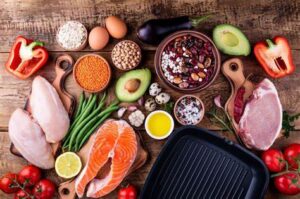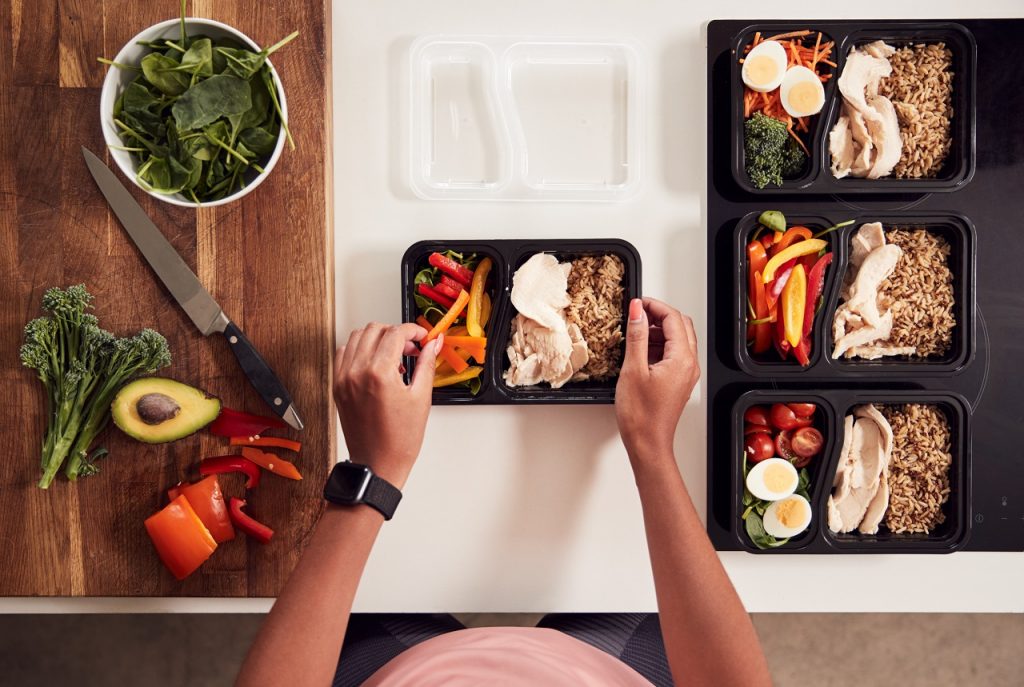Portion control, which allows you to manage how much you eat, can be helpful for weight loss. This helps prevent overeating, which contributes to weight gain. Your portions can increase your calorie intake if they’re too large. You may opt for a smaller plate, start each meal with a glass of water, eat more slowly, and keep a food diary.
Making these diet changes also doesn’t mean you have to feel hungry. People who gradually lose weight through healthy eating and regular exercise are most successful in maintaining weight. They focus less on calorie deficits and more on living healthfully. Read on to learn if portion control is a good way to lose weight and how to practice it.
What is Portion Control
Portion control helps you manage how much food you eat in one sitting. You’ll figure out how many calories you want to consume and then select the amount of food accordingly.
You can use portion control to lose or maintain weight. To lose weight, it’s important to create a calorie deficit, in which you burn more calories than you take in. How many calories you need to consume to lose weight depends on several factors, such as age, gender, height, and exercise.
A healthcare provider can figure out a calorie intake that suits your personal goals and helps you portion control. You can also use the following methods to reduce overeating and support weight loss.
Here are Tips for Portion Control
1. Choose a Smaller Plate
One simple way to control the portion of food you put on your plate is to use a smaller plate. A study published in 2015 found that using smaller plates, knives, forks, glasses, and other tableware could reduce the amount of food you eat. The researchers also suggested that completely eliminating larger portions from the diet could reduce calorie intake by up to 29% among adults in the U.S.
2. Use the Plate as a Portion Guide
Another good way to reduce calories is to rethink the food groups on your plate. The plate method, for example, can help you control portion size and support weight loss.
Start with a 9-inch plate and then fill it as follows:
- Half with non-starchy vegetables, such as broccoli, Brussels sprouts, or cauliflower
- One-quarter with lean proteins, such as chicken, beans, or hummus
- One-quarter with whole grains, such as brown rice or whole-wheat pasta
3. Understand Serving Size
A portion is different from the serving size you see printed on the nutrition facts label. You may see the serving size measured in cups, grams, ounces, or pieces.
Keep in mind that this number might be more or less than your chosen portion size. You’ll want to scan the nutrition facts label or the menu at a restaurant to figure out what amount matches your weight loss goals.
4. Use Your Hands to Measure
Use easy, memorable visual cues for healthy awareness of how much of a food you’re eating. You can even use your hands to measure out portions:
- Carbohydrates: One rounded handful
- Dried fruits and nuts: One small handful
- Fruits and vegetables: One fist-size
- Meat or poultry: One palm-size
5. Use Color-Contrasting Dinnerware
The color of your plate may influence how much you eat. Some evidence suggests that using plates that have a color contrast to the food you’re eating for dinner, like pasta with red sauce on a white plate, can help you eat less.
If you want to eat more of a food, you can use a dish of the same color. Try eating more green vegetables from a large green plate or bowl, for example.
6. Start with Glass of Water
Drink 16 ounces (oz) of water before you eat. Filling your stomach with water will naturally make you less likely to overeat.
Some dehydration symptoms may actually be what’s causing you to feel hungry. Drink water when you’re feeling hungry. Thirst is often confused with hunger, so sipping some water before you eat may reduce what feels like hunger.
7. Eat Soup Before Your Meal
Have some soup before you dig into your entrée. Adding more to your meal may seem counterintuitive, but consuming soup could make you feel fuller, similar to water. Research has shown that harder and more solid textures can satisfy your appetite.
Chunky or viscous soups may be particularly helpful in making you feel sated. Try a broth-based soup, preferably with vegetables for fiber.
8. Drink From a Tall Straight Glass
You can have alcohol or a soft drink with your meal, but limit it to one glass and enjoy it slowly. Research has found that people drink slower and less from glasses that are straight-edged, compared to outward-sloped.
The American Heart Association (AHA) recommends that you limit your consumption of sugary beverages. Just one 12-oz can of regular soda contains 10 teaspoons (tsp) of sugar, which is a full 4 tsp more than what’s recommended for females per day or 1 tsp more for males. Experts advise adult females to limit themselves to one drink and adult males to two drinks or less in a day.
9. Don’t Eat From Bag or Box
You may not pay attention to how much you’re eating when you sit down with a bag of chips. A study published in 2021 found that people eating snacks from smaller containers ate less compared to people eating from larger packages.
You might be unaware of serving sizes when eating from a larger package. A smaller container serves as a visual cue for when you’ve eaten a full portion. You can also apply this logic to snacks. Divide the contents into smaller containers ahead of time if you buy a bag of pretzels or a tin of nuts that contains several servings.
10. Eat Plenty of Fiber
Bulking up your meals with vegetables is one easy way to cut calories while making you feel full.
Spinach, for example, can be used as a sandwich topper or to add fiber and nutrients to pasta and stir-fries.
Other ideas for eating more vegetables include:
- Adding diced apples to your oatmeal
- Replacing meat with mushrooms
- Using a whole-wheat pita in place of bread so you can stuff it with more vegetables
11. Eat Slowly
Taking your time while eating increases enjoyment and decreases portions.
Dimming the lights and listening to relaxing music set the tone for a more leisurely meal. Remember to chew slowly, put your fork down between bites, and sip water to make your meal last longer.
Another way to slow down your eating speed is to try foods that require shelling, peeling, or individual unwrapping. Some options include oranges, edamame, and pistachios in their shells.
12. Limit Mealtime Distractions
Turn off the TV, stop working, and put your smartphone away while you eat. Research has shown that people eat more calories if they use their phones during their meals.
Consider avoiding using your lunch break to work if you can. Some evidence suggests that people feel less full if they eat while working at a computer.
13. Ask for Less
It can be difficult to practice portion control when you eat out, and restaurants can sometimes serve large portions. Try asking for a smaller size or scan the menu for two appetizers or side dishes instead of one large meal.
Other tips for eating out include:
- Ask a family member or friend to split a meal with you.
- Ask a waiter not to bring a basket of bread or chips to the table before your meal.
- Inquire about the nutrition information, which can often be found on the menu or the restaurant’s website.
- Opt for a restaurant that serves controlled portions instead of a buffet.
14. Enjoy a Healthy Sweet Treat
Many people expect to eat some type of dessert at the end of a meal. Brew a flavorful decaf tea like peppermint, cinnamon, chocolate, or a fruity variety to satisfy this expectation. Reach for a bowl of fruit or small sweet potato topped with cinnamon and peanut butter for a nutrient-rich option.
15. Keep a Food Diary
It might be helpful to keep a food diary to hold yourself accountable. You may jot your food portions in a journal, on a notes app on your cellphone, or on an app designed to keep track of your calorie intake.
You might track the following information:
- What you eat, and how much
- When you eat
- Where you eat
- Why you eat (e.g., hunger or boredom)
This information can help you visualize your eating habits and make changes accordingly. You may notice that you often skip lunch, for example, which causes you to overeat later in the evening.
Frequently ask questions
-
Is portion control a good way to lose weight?
Portion control helps you manage your calorie intake, which is essential for weight loss. You lose weight when you create a calorie deficit, meaning you burn more calories than you take it.18 Portion control helps make sure you’re not eating more calories than you burn.
-
Can portion control help you lose belly fat?
You might be able to reduce body fat using portion control. Research has shown that portion control can prevent overeating and may reduce cravings, both of which contribute to fat gain.19
-
How much weight can you lose in a month with portion control?
If you use portion control to eat about 500 fewer calories, you can lose about one to two pounds per week, which can result in four to eight pounds lost per month.


